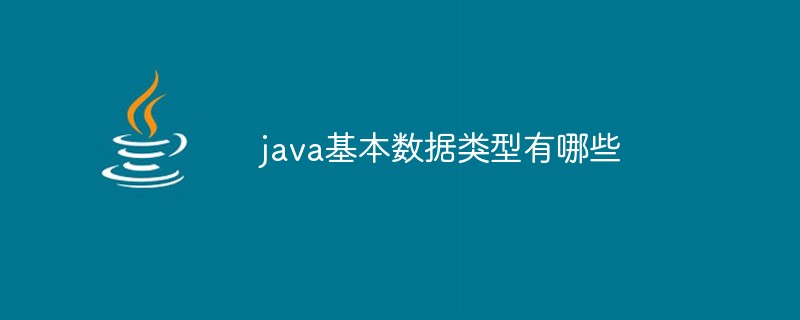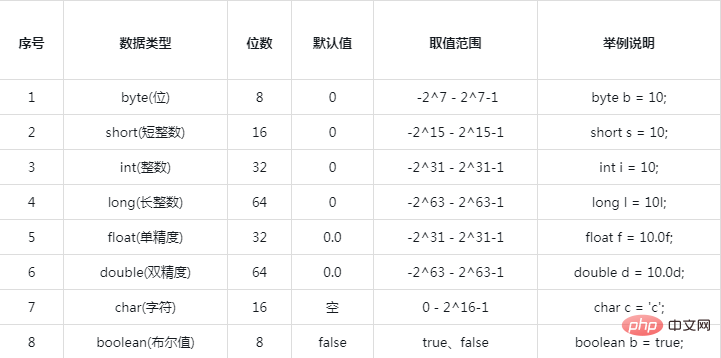What are the basic data types of java
There are 8 basic data types in Java, namely: byte (bit), short (short integer), int (integer), long (long integer), float (single precision), double (double precision) ), char (character) and boolean (Boolean value).

The operating environment of this tutorial: windows7 system, java10 version, DELL G3 computer.
About Java’s 8 basic data types, their names, digits, default values, value ranges and examples are shown in the following table:

In order to verify the contents of the table, run the verification code in eclipse as follows:
package com.ce.test;
class Test {
static byte b;
static short s;
static int i;
static long l;
static float f;
static double d;
static char c;
static boolean bo;
public static void main(String[] args) {
System.out.println("byte的大小:"+Byte.SIZE
+";默认值:"+b
+";数据范围:"+Byte.MIN_VALUE+" - "+Byte.MAX_VALUE);
System.out.println("short的大小:"+Short.SIZE
+";默认值:"+s
+";数据范围:"+Short.MIN_VALUE+" - "+Short.MAX_VALUE);
System.out.println("int的大小:"+Integer.SIZE
+";默认值:"+i
+";数据范围:"+Integer.MIN_VALUE+" - "+Integer.MAX_VALUE);
System.out.println("long的大小:"+Long.SIZE
+";默认值:"+l
+";数据范围:"+Long.MIN_VALUE+" - "+Long.MAX_VALUE);
System.out.println("float的大小:"+Float.SIZE
+";默认值:"+f
+";数据范围:"+Float.MIN_VALUE+" - "+Float.MAX_VALUE);
System.out.println("double的大小:"+Double.SIZE
+";默认值:"+d
+";数据范围:"+Double.MIN_VALUE+" - "+Double.MAX_VALUE);
System.out.println("char的大小:"+Character.SIZE
+";默认值:"+c
+";数据范围:"+Character.MIN_VALUE+" - "+Character.MAX_VALUE);
System.out.println("boolean的大小:"+Byte.SIZE
+";默认值:"+bo
+";数据范围:"+Byte.MIN_VALUE+" - "+Byte.MAX_VALUE);
}
}The output result on the console is as shown below:

Why is the data range of the output char here not 0 - 65535?
The char type in Java is represented by two bytes, that is, sixteen bits. Because it is an unsigned number, it is 2 to the 16th power, and the value range is: 0 - 2^16-1;
Recommended related video tutorials: Java video tutorial
The above is the detailed content of What are the basic data types of java. For more information, please follow other related articles on the PHP Chinese website!

Hot AI Tools

Undresser.AI Undress
AI-powered app for creating realistic nude photos

AI Clothes Remover
Online AI tool for removing clothes from photos.

Undress AI Tool
Undress images for free

Clothoff.io
AI clothes remover

AI Hentai Generator
Generate AI Hentai for free.

Hot Article

Hot Tools

Notepad++7.3.1
Easy-to-use and free code editor

SublimeText3 Chinese version
Chinese version, very easy to use

Zend Studio 13.0.1
Powerful PHP integrated development environment

Dreamweaver CS6
Visual web development tools

SublimeText3 Mac version
God-level code editing software (SublimeText3)

Hot Topics
 1376
1376
 52
52
 Square Root in Java
Aug 30, 2024 pm 04:26 PM
Square Root in Java
Aug 30, 2024 pm 04:26 PM
Guide to Square Root in Java. Here we discuss how Square Root works in Java with example and its code implementation respectively.
 Perfect Number in Java
Aug 30, 2024 pm 04:28 PM
Perfect Number in Java
Aug 30, 2024 pm 04:28 PM
Guide to Perfect Number in Java. Here we discuss the Definition, How to check Perfect number in Java?, examples with code implementation.
 Random Number Generator in Java
Aug 30, 2024 pm 04:27 PM
Random Number Generator in Java
Aug 30, 2024 pm 04:27 PM
Guide to Random Number Generator in Java. Here we discuss Functions in Java with examples and two different Generators with ther examples.
 Weka in Java
Aug 30, 2024 pm 04:28 PM
Weka in Java
Aug 30, 2024 pm 04:28 PM
Guide to Weka in Java. Here we discuss the Introduction, how to use weka java, the type of platform, and advantages with examples.
 Smith Number in Java
Aug 30, 2024 pm 04:28 PM
Smith Number in Java
Aug 30, 2024 pm 04:28 PM
Guide to Smith Number in Java. Here we discuss the Definition, How to check smith number in Java? example with code implementation.
 Java Spring Interview Questions
Aug 30, 2024 pm 04:29 PM
Java Spring Interview Questions
Aug 30, 2024 pm 04:29 PM
In this article, we have kept the most asked Java Spring Interview Questions with their detailed answers. So that you can crack the interview.
 Break or return from Java 8 stream forEach?
Feb 07, 2025 pm 12:09 PM
Break or return from Java 8 stream forEach?
Feb 07, 2025 pm 12:09 PM
Java 8 introduces the Stream API, providing a powerful and expressive way to process data collections. However, a common question when using Stream is: How to break or return from a forEach operation? Traditional loops allow for early interruption or return, but Stream's forEach method does not directly support this method. This article will explain the reasons and explore alternative methods for implementing premature termination in Stream processing systems. Further reading: Java Stream API improvements Understand Stream forEach The forEach method is a terminal operation that performs one operation on each element in the Stream. Its design intention is
 TimeStamp to Date in Java
Aug 30, 2024 pm 04:28 PM
TimeStamp to Date in Java
Aug 30, 2024 pm 04:28 PM
Guide to TimeStamp to Date in Java. Here we also discuss the introduction and how to convert timestamp to date in java along with examples.




